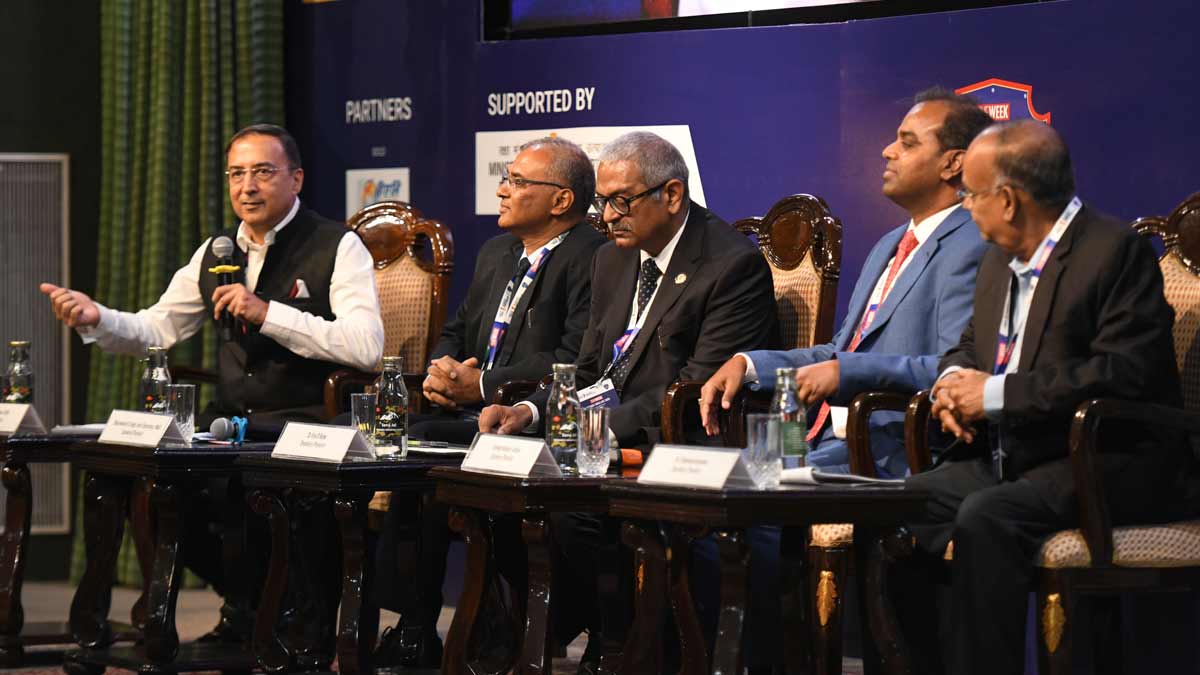‘India is ready to make for the world’
 (From left) Maj Gen KV Jauhar, former DG, Army Design Bureau (ADB) (M); Dharmendra K Singh, Joint Secretary and Acquisition Manager (Air), Ministry of Defence; Dr Atul D Rane, former CMD, Brahmos; Venkat Katkuri, Head, Defence and Space, India & South Asia, Airbus; Dr C Ramanarayanan, former Director GTRE during the panel discussion
(From left) Maj Gen KV Jauhar, former DG, Army Design Bureau (ADB) (M); Dharmendra K Singh, Joint Secretary and Acquisition Manager (Air), Ministry of Defence; Dr Atul D Rane, former CMD, Brahmos; Venkat Katkuri, Head, Defence and Space, India & South Asia, Airbus; Dr C Ramanarayanan, former Director GTRE during the panel discussion
Much has been talked about India’s thriving defence ecosystem and its growing prowess in research, development and manufacturing. But is India ready to manufacture for the world?
Many experts who discussed the topic ‘How ready is India to Make for the World’ at THE WEEK Defence Conclave 2025 in Delhi were of the opinion that it is.
Advantage of being neutral
Maj Gen K.V. Jauhar, former DG, Army Design Bureau, who moderated the session said India's strategic geopolitical positioning helps the cause a lot. He said some path-breaking policy reforms which were put into place by the government in the past decade, the push towards the Make in India, Atma Nirbharta in defence, and the private defence industry maturing itself to be able to deliver to the demands of the world were also important factors. The remarkable rise in the defence innovation ecosystem with MSME startups coming up and working on niche technology also was important.
Focus on our strengths
Dharmendra K. Singh, joint secretary and acquisition manager at MoD, said India is very much ready to make for the world and it was ready in fact a few years back when Prime Minister Narendra Modi brought the policy of Atma Nirbharta.
“There are two aspects when we talk about export or make for the world,” he said. “First we have to focus on meeting our own requirement—the requirement of our own services to become self-dependent. In the process we will also be able to make for the world. India has to identify its strengths; the areas where it can create, manufacture products that can be supplied to the world.
There should be a framework by the government where transfer of technology can be facilitated and the scope of that TOT should be clearly defined. Then there should be a stable tax regime so that any company which wants to come to India has a good environment. Simplification of export licensing is already being done. Also India’s non-aligned stand should be leveraged for promoting exports.
Scaling up is the key
Dr Atul D. Rane, former CMD, Brahmos, said India is ready to make for the world, but we should first be able to make for India.
The private industry has grown; now they need to step up their production to reach the level of wetting the appetite of the Indian defence forces and scaling up for exports.
Scaling up is not only for exports. It is also for in case of an attrition at some point of time. It is a double-edged weapon—the industry needs to scale up and this will make us absolutely ready to make for the world.
Our exports have gone up because of our policies. The government has supported the industry in that. The PSUs have always been ahead of the private players, but it is now changing slowly.
Invest in the future
Dr C. Ramanarayana, former director of GTRE, said whoever thinks of exporting continuously to different countries should also start investing in higher versions of those technologies. “We are able to make systems or products, and supply them for three years or years. But the pace at which technology changes will make all our things obsolete in the next five years.”
If you take the five companies or the four countries that manufacture jet engines, they also have a civil engine programme. That is the only way they can economically sustain. If you are limiting ourselves only to military aircraft engines, it's a very difficult decision.
A bus which we are in the process of missing is quantum communication and quantum computing. The government has allotted quite a substantial (amount for the quantum mission, but the people who run the programme are socialist in nature and they have uniformly distributed the money across the country. Nothing will come out. If you want to realise the quantum computer, you need to focus on deliverables as products and around that you work out what is the research and development to be done or designed to be done and accordingly allot your projects to the people.
Ready for bigger things
Venkat Katkuri, head of defence and space, India and South Asia, Airbus, said India is ready for exports because it is a right mix of competitiveness and competencies.
Airbus has established two final assembly lines and two pilot training centres in India. It has increased its sourcing from a mere $500 million in 2019 to $1.4 billion in 2024.
Is Airbus ready for exports? There is a gestation period, particularly in the aerospace industry. But we have to realise India, at least the large tier ones in India today, are evolving from build-to-print to build-to-specification.
It's not just for defence alone, but we are encouraging the Indian ecosystem to be an integral part of the Airbus supply chain globally as well.
India has improved tremendously on the ease of doing business, but the speed of doing business is equally important because of technology obsolescence.
Defence